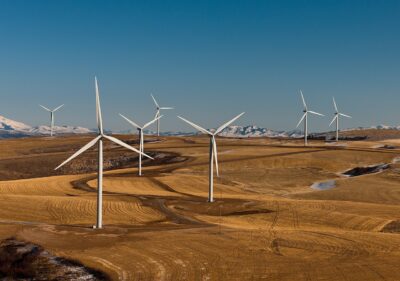How to Harvest and Store Wind Energy
Renewable energy is sustainable, clean energy harvested from sources that do not deplete with use or are replenished on a human timescale. This is in contrast to non-renewable energy sources, like oil, coal and natural gas, which are derived from a finite resource. Solar and wind power are examples of renewable energy sources. Harvesting energy from the Sun and wind today will not result in less sunshine or wind tomorrow. 
Wind energy is an underutilized renewable energy source. Many people are familiar with the idea of wind power, but not quite certain exactly what it is or how it is used. This brief introduction of wind power provides basics on what wind energy is, how it is harvested, and how it is stored for future use.
What is Wind Power?
Wind power is the use of the wind’s kinetic energy to generate electricity or mechanical power. The use of wind power to pump water and grind grain has been around for centuries. In a basic windmill, the force of the wind pushes against the front side of the sails of the windmill causing them to turn. This rotation in mainly caused by drag. The sails are attached to a horizontal windshaft so when the sails turn, the windshaft turns. This rotary motion is then converted into mechanical power and can turn the wheel of a grist mill or pump water.
When people talk about harvesting wind energy today however, they tend to be talking about converting the wind’s kinetic energy into electricity. This is a similar process to the ancient windmill, except the mechanical power in the rotor shaft is used to rotate an electric generator, producing electricity.
How is Wind Energy Harvested?
Harvesting wind energy for electricity operates on the same basic principles of older windmills. The specialty windmills that are used to convert wind energy into electricity are called wind turbines. There are two different types of wind turbines, horizontal-axis and vertical-axis. In vertical-axis wind turbines, the main rotor shaft (similar to the windshaft of older windmills) is set vertically, or perpendicular to the ground. In horizontal-axis wind turbines, the main rotor shaft is set horizontally and the blades are perpendicular to the ground. Most commercial wind turbines that are connected to the electrical grid are horizontal-axis wind turbines.

Modern horizontal-axis wind turbines are tall towers that typically have two or three blades. At the top of the the tower is a weather vane which is connected to a computer. This keeps the turbine facing into the wind. Like with the windmill, the wind moves the blades of the wind turbines. Although, the blades of the turbine work more like the wing of an airplane than windmill sails. When the wind blows, a pocket of low pressure air is formed on the back side of the blade, accompanying an area of high pressure air on the front. This creates a pressure differential and an aerodynamic force known as lift. Lift causes the blades to spin which, in turn, spins the main rotor shaft that is connected to a generator. The electric generator converts the mechanical energy of the rotor shaft into electricity.
How is Wind Energy Stored?
One of the challenges of wind power is the intermittent nature of the wind. Even in the optimum locations for wind harvesting, there is no way to guarantee the wind will be providing enough energy to meet the demand for electricity at any given time. Currently, wind energy is a supplemental source of energy for electrical power grids. Moving forward and away from finite energy sources will require a greater dependence on renewable sources like wind energy. In order to ensure consistent and reliable electricity, wind energy needs to be able to be stored. The wind itself cannot be stored, but there are few ways to store wind energy.
Many storage solutions for wind energy have a high initial cost. At the moment, it is far less expensive to keep wind energy as one piece of a varied and flexible energy grid than it is to store wind energy. According to the American Wind Energy Association, wind turbines currently produce enough electricity to power over 15 million homes in America. While impressive, the wind could power much more. In fact, the United States wind energy potential exceeds the nation’s electricity needs by more than 10 times.
It is possible to meet America’s electricity needs from renewable energy sources alone. With the right energy storage technology, these needs could be met from only wind energy. In order to access this potential and move away from finite energy sources like fossil fuels, more wind energy storage solutions need to be explored. The development of future technologies capable of storing energy is essential to fully harness the power of abundant renewable energy sources.
 " alt="">
" alt="">